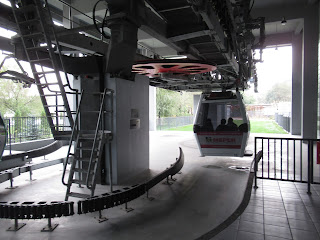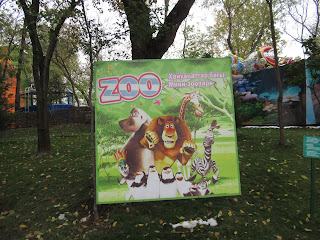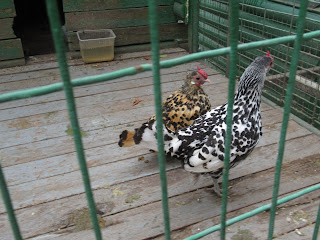We wandered around Almaty's Green Bazaar, so called because of its green (!) exterior color, as I needed another long sleeved shirt because of the chilly weather we had then and would also be experiencing in the next couple of months of our trip. I wish I could say I haven't had much need to wear the shirt since then but the opposite is true as we've had stinking cold weather ever since, it seems!

There weren't a lot of sights we were still curious to still see in Almaty but one was the Kazakh Museum of Folk Instruments. It was in a striking 1908 wooden building that reopened in 2013 after a full revamp. The work of art, almost like a church in design, was originally an army officers' barracks and became the music instruments museum in 1980.
The dombra is a two-stringed plucked musical instrument with an oval boxed shape similar to a lute and is the national instrument of Kazakhstan. This one, made from wood and fishing line, came from eastern Kazakhstan and won the Grand Prix of the II Republican competition (for making dombras) in 2018.
The maker of this dombra received second place honors.
The zhetigen is a many stringed plucked instrument also made of wood and fishing line. The maker of this one received the Order of Honors medal in 2013.
The three clay wind instruments were dated from the 9th to the 12th centuries, although strangely only the one on the left was marked as being a copy.
The copy of the 13th century wood dombra was found in a nomadic burial complex in Saratov, now a city in Russia.
I thought it interesting that the shaman's stones, dating from the 8th to the 12th centuries, were depicted with a variety of traditional Kazakh instruments on them as I had never seen that before. From left to right the instruments were a kobyz, konyran and a bow-monochord, a one-string instrument.
Rock paintings from the 6th century also showed the dombra surrounded by dancers and a shaman playing a musical instrument surrounded by spirits.
This was a bugyshak, a wind instrument made from wood, plastic and horn. There was no info on its age, however.
I was very curious what the display on puppet art had to do with folk musical instruments.
At the top was a wood and leather percussion instrument; on the left were a variety of wood noisemakers.
Different types of kobyz, a stringed bowed instrument made of wood, leather and horsehair, that sounds like a fiddle. I read that its sound is said to have brought Genghis Khan to tears.
The zhelbuaz, a 20th century wind instrument made of reed, leather and metal, looked very much like a bagpipe to me.
Types of 20th century noisemakers called konyrau and made of wood and metal:
The 20th century copper, wood and leather noisemakers were called shyn.
This 20th century percussion noisemaker made of wood, leather and metal was a dudyga.
This wood, leather and metal percussion instrument was a kind of dauylpaz.
The sign said this was a garmon, a reed wind instrument, that looked so much like an accordion.
Another room had similar instruments from other countries. The zither, a German plucked instrument, was the only instrument I had been aware of to that point.
Tam-tams from the Congo:
A bowed instrument from Laos:
The sasando, a plucked instrument, was from Indonesia.
It would have been fantastic if we'd been able to attend a concert inside the museum where musicians occasionally play the instruments from the collection. But at least, there was piped music played constantly which brought the instruments to life.
With music being an intrinsic part of Kazakh culture, this museum helped us to understand Kazakhstan a bit better. It would have been great if there were videos of how the instruments were played. I also found lacking the absence of information about the history of folk music in the country and the background of the instruments themselves so the simple presence of the instruments was insufficient for me.

To get a panoramic view of the city and the surrounding mountains, we took a cable car ride up to Kok-Tobe, the 1100 meter above sea level hill on the city's southeastern edge which was crowned by a 372 meter tall TV tower.
Unlike cable car operators elsewhere, there were no staff to ensure people got in the cars safely which I thought was surprising.
As you can see, it was a particularly cloudy day to take a cable car ride, but even so the views were attractive as we rose above the city.
What a beautiful view this would have been on a clear day.
Surprise, surprise, I say sarcastically, there was another ferris wheel at the top of Kok-Tobe, as it was the second one we'd seen in just two days.
Did you notice the upside down house in the above photo? We chuckled seeing it and took a few minutes to look at it further.
I read that Almaty, whose old name 'Alma-Ata’ means 'father of apples’ in Kazakh, has claimed the honor of being birthplace of the apple for more than a hundred years. It does so on the grounds that 'Malus Sieversii,' the wild variety that grows on the slopes of the nearby Tien Shan Mountains, is the apple’s true ancestor. There seems to be some truth to the Kazakh claim as it has been discovered the apple did originate from the area after the first complete sequencing of its genome.
There was a line to dress up in some big fur coats and hats or was it only to try and get warm for a few minutes, I wondered?!
If the weather had been warmer, there were some walking trails on the ridge that would have been enjoyable. But we still had decent views toward Almaty and the mountains surrounding it
It was quite strange to first hear The Beatles music coming from somewhere in the trees and then finding their statues set in a park on the hill! What a lark, though, as we waited so Steven could have his photo taken on the seat next to John.
I’m not sure what the 'relevance' of this monument was but it was heartwarming to see how people from all nations still loved their music and that it brings people together all these years later. I shall always think of this moment in Almaty when I hear their song In My Life as we heard it play several times.
As we climbed further up the hill, we could see the TV tower through the trees.
We had no idea ahead of time there was a small zoo at the top of the hill. We had fun seeing the guancao, a relative to a llama, as it reminded us of all the ones we'd seen just a year ago in the mountainous regions of Peru and Chile.
I can hardly believe in a few short months a friend and I will be traveling to New Zealand and then a small part of Australia for a few weeks together! I wonder if we'll see any emus while in the latter country, Diane!
The sign said the black and white variety of chickens were called Japanese Benthic and that they are generally considered to have originated in the Netherlands and known to have existed since the 14th century. We had never seen any like that before.
Another new animal to us was the Chinese Silk Chicken, apparently a very ancient breed, the first representatives of which were bred in China. They were bred as ornamental birds as well as for medical purposes.
The colorful Chinese Imperial Pheasant, whose homeland is obviously China, lives in southern Russia and eastern Mongolia. They eat bamboo shoots and leaves of various shrubs.
It was cute watching it 'making nice' with the Semirechye's Pheasant.
The Chrysolophus Pictus was from central China.
Another animal that caught our attention was the White Peacock that is widespread in Bangladesh, Nepal, Pakistan, India and Sri Lanka. It lives in jungles and wooded areas, on cultivated lands and near villages up to 2,000 meters above sea level and eats various grains, roots, vegetables and cake - huh!!
This is just a photograph of the white peacock with its feathers extended. How I would love to have seen one of them do it that day!
I am sure on a nicer day, the attractions would have lured lots of children.
There weren't any takers for the high ropes course that day. I would like to do one some day.
The views on our descent looked even dimmer than they had been just a couple of hours earlier.
It was hard to tell but I think this was an apple design to denote the fruit's importance to the city.
When we briefly first visited Almaty about a month previously, neither of us had been very impressed. However, after a few more days in the country's former capital, I was very impressed with its superlative Arts Museum, the parks and commitment to public art.
Next post: On to Astana, Kazakhstan's capital.
Posted on November 16th, 2018, from Madrid, Spain.








































































Nice idea!! Thank you so much for such information.I’ve been waiting patiently for your next blog entry!
ReplyDeleteTernopil State Medical University
Hope you're enjoying the posts I wrote on Kazakhstan as it was a country I found very intriguing and fascinating. So sad, though, reading about its recent political strife.
ReplyDelete